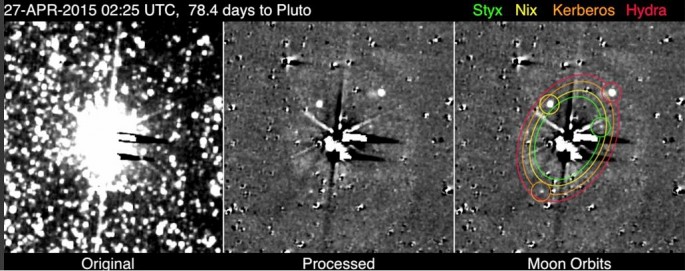NASA's New Horizons spacecraft for the first time has photographed Kerberos and Styx, the smallest and dimmest of Pluto's five known moons.
Some astronomers believe a sixth Plutonian moon might be out there and its discovery by New Horizons would be a bonus to the mission that began on January 19, 2006.
As it closes in on Pluto by mid-May, New Horizons will begin its first search for this new moon or moons and a ring system whose existence was suggested by the discovery in 2005 of the moons, Nix and Hydra. Charon is the other Plutonian moon.
Kerberos and Styx were discovered in 2011 and 2012, respectively, by New Horizons team members using the Hubble Space Telescope. Styx orbits Pluto every 20 days and might have a diameter of 21 kilometers. Kerberos orbits every 32 days and might have a diameter ranging from 10 km to 30 km.
New Horizons is now within sight of all the known members of the Pluto system following its detection of Pluto's giant moon Charon in July 2013, and Pluto's smaller moons Hydra and Nix in July 2014 and January 2015, respectively,.
"New Horizons is now on the threshold of discovery," said mission science team member John Spencer, of the Southwest Research Institute in Boulder, Colorado.
"If the spacecraft observes any additional moons as we get closer to Pluto, they will be worlds that no one has seen before."
The images of Kerberos and Styx were taken by New Horizons' most sensitive camera, the Long Range Reconnaissance Imager (LORRI), from April 25 to May 1. Each observation consisted of five 10 second exposures that were added together to make the image in the left panel.
Images were extensively processed to reduce the bright glare of Pluto and Charon and largely remove the dense field of background stars (center and right panels). This reveals the faint satellites, whose positions and orbits -- along with those of brighter moons Nix and Hydra -- are shown in the right panel.
"Detecting these tiny moons from a distance of more than 55 million miles is amazing, and a credit to the team that built our LORRI long-range camera and John Spencer's team of moon and ring hunters," added New Horizons Principal Investigator Alan Stern of the Southwest Research Institute.
Kerberos is visible in all of the images, though is partially obscured in the second image. Styx is not visible in the first image, only in subsequent ones.
The Johns Hopkins University Applied Physics Laboratory designed, built and operates the New Horizons spacecraft, and manages the mission for NASA's Science Mission Directorate.
Southwest Research Institute leads the science team, payload operations and encounter science planning. New Horizons is part of the New Frontiers Program managed by NASA's Marshall Space Flight Center in Huntsville, Alabama.



























